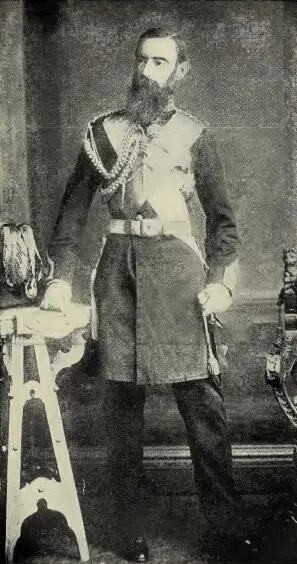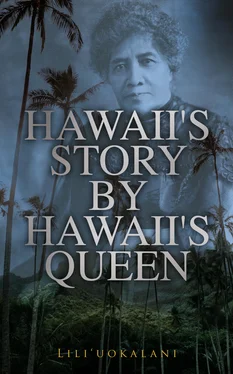Liliʻuokalani
Hawaii's Story by Hawaii's Queen
e-artnow, 2021
Contact: info@e-artnow.org
EAN 4064066500382
Chapter I. A Sketch of My Childhood
Chapter II. Some Incidents of My Youth
Chapter III. Kamehameha Iv
Chapter IV. My Married Life
Chapter V. Hawaiian Music, and a Ducal Guest
Chapter VI. Kamehameha V
Chapter VII. Queen Emma
Chapter VIII. King Kalakaua
Chapter IX. Heir Apparent
Chapter X. My First Visit to the United States
Chapter XI. Mauna Loa
Chapter XII. Kalakaua's Tour of the World
Chapter XIII. My Regency
Chapter XIV. A Serious Accident
Chapter XV. Kalakaua's Return
Chapter XVI. Coronation Ceremonies
Chapter XVII. Princess Ruth and Mrs. Bernice Pauahi Bishop
Chapter XVIII. Benevolent Societies
Chapter XIX. Queen Kapiolani's Journey
Chapter XX. Washington – the White House – Mount Vernon
Chapter XXI. Boston and New York – en Route for England
Chapter XXII. Arrival – Liverpool – Some English Towns
Chapter XXIII. Sovereign of England and India
Chapter XXIV. The Reception at the Foreign Office
Chapter XXV. The Jubilee – at the Abbey – at the Palace
Chapter XXVI. The Prince of Wales, "Grand Master" Mason
Chapter XXVII. England's Homes and Hospitality
Chapter XXVIII. Ill News From Hawaii – Our Return
Chapter XXIX. "The Bayonet Constitution"
Chapter XXX. Invited to Conspire Against the King
Chapter XXXI. The King Threatened and Oppressed
Chapter XXXII. Attempted Revolution
Chapter XXXIII. The King's Departure – Again Regent
Chapter XXXIV. The King's Return – My Accession
Chapter XXXV. The Last Sleep – Lying in State
Chapter XXXVI. My Cabinet – Princess Kaiulani
Chapter XXXVII. My Husband Made Prince Consort – His Death
Chapter XXXVIII. Hawaiians Plead for a New Constitution
Chapter XXXIX. The "Crimes I Am Charged Withal."
Chapter XL. Overthrow of the Monarchy
Chapter XLI. Some Important Inquiries
Chapter XLII. Attempt to Restore the Monarchy
Chapter XLIII. I Am Placed Under Arrest
Chapter XLIV. Imprisonment – Forced Abdication
Chapter XLV. Brought to Trial
Chapter XLVI. Sentenced – My Prison Life
Chapter XLVII. Released on Parole
Chapter XLVIII. Mr. Joseph Kahooluhi Nawahi
Chapter XLIX. A Change of Scene to Forget Sorrow
Chapter L. A New England Winter
Chapter LI. Washington – Pseudo-Hawaiians
Chapter LII. President and Mrs. Cleveland
Chapter LIII. Inauguration of President Mckinley
Chapter LIV. My Literary Occupation
Chapter LV. My Official Protest to the Treaty
Chapter LVI. The Treaty Analyzed
Chapter LVII. Hawaiian Autonomy
Appendix A
Appendix B
Appendix C
Appendix D
Appendix E
Appendix F
Appendix G
 HER MAJESTY, QUEEN LILIUOKALANI
HER MAJESTY, QUEEN LILIUOKALANI
 HIS ROYAL HIGHNESS THE PRINCE CONSORT, JOHN OWEN DOMINIS
HIS ROYAL HIGHNESS THE PRINCE CONSORT, JOHN OWEN DOMINIS
Chapter I.
A Sketch of My Childhood
Table of Contents
THE extinct crater or mountain which forms the background to the city of Honolulu is known as the Punch-Bowl; at its base is situated the Queen's Hospital, so named because of the great interest taken in its erection by Emma, the queen of Kamehameha IV. Funds for the cause were solicited by the reigning sovereigns in person, and the hospital building was completed in 1860. Very near to its site, on Sept. 2, 1838, I was born. My father's name was Kapaakea, and my mother was Keohokalole; the latter was one of the fifteen counsellors of the king, Kamehameha III., who in 1840 gave the first written constitution to the Hawaiian people. My great-grandfather, Keawe-a-Heulu, the founder of the dynasty of the Kamehamehas, the Keoua, father of Kamehameha I., were own cousins (he was also brother of Mrs. Bishop's ancestress, Hakau), and my great-grandaunt was the celebrated Queen Kapiolani, one of the first converts to Christianity. She plucked the sacred berries from the borders of the volcano, descended to the boiling lava, and there, while singing Christian hymns, threw them into the lake of fire. This was the act which broke forever the power of Pele, the fire-goddess, over the hearts of her people. Those interested in genealogies are referred to the tables at the close of this volume, which show the descent of our family from the highest chiefs of ancient days. It has often happened in the history of nations that the most eminent men have won the crown, and then, instead of ascending the throne, have placed the executive office in the hands of another. Kamehameha I. was, indeed, the founder of Hawaiian unity, and worthy of the surname of the Great; but it is truthfully recorded in the early histories of the Islands, – those written by such men as Mr. Pogue, Mr. Dibble, and others, – that he owed his selection for the monarchy to the chiefs from whom the latest reigning family, my own, is descended. This indebtedness was fully recognized during the life of that monarch.
Naihe, the husband of Kapiolani, was the great orator of the king's reign; his father, Keawe-a-Heulu, was chief counsellor to Kamehameha I.; while had it not been for the aid of the two chiefs, Keeaumoku and Kameeiamoku, cousins of the chief counsellor, the Hawaiian Islands must have remained for a long time, if not until this day, in a state of anarchy. My grandfather, Aikanaka, had charge of the guns of the fort on Punch-Bowl Hill, which had been brought from the larger island of Hawaii; as the chiefs, their families, and followers had settled here from the time of the final battle, when all the forces contending against Kamehameha I. were driven over the Pali.
For the purpose of enhancing the value of their own mission, it has been at times asserted by foreigners that the abundance of the chief was procured by the poverty of his followers. To any person at all familiar, either by experience or from trustworthy tradition, with the daily life of the Hawaiian people fifty years also, nothing could be more incorrect than such assumption. The chief whose retainers were in any poverty or want would have felt, not only their sufferings, but, further, his own disgrace. As was then customary with the Hawaiian chiefs, my father was surrounded by hundreds of his own people, all of whom looked to him, and never in vain, for sustenance. He lived in a large grass house surrounded by smaller ones, which were the homes of those the most closely connected with his service. There was food enough and to spare for every one. And this was equally true of all his people, however distant from his personal care. For the chief always appointed some man of ability as his agent or overseer. This officer apportioned the lands to each Hawaiian, and on these allotments were raised the taro, the potatoes, the pigs, and the chickens which constituted the living of the family; even the forests, which furnished the material from which was made the tapa cloth, were apportioned to the women in like manner. It is true that no one of the common people could mortgage or sell his land, but the wisdom of this limitation is abundantly proved by the homeless condition of the Hawaiians at the present day. Rent, eviction of tenants, as understood in other lands, were unknown; but each retainer of any chief contributed in the productions of his holding to the support of the chief's table.
Читать дальше

 HER MAJESTY, QUEEN LILIUOKALANI
HER MAJESTY, QUEEN LILIUOKALANI HIS ROYAL HIGHNESS THE PRINCE CONSORT, JOHN OWEN DOMINIS
HIS ROYAL HIGHNESS THE PRINCE CONSORT, JOHN OWEN DOMINIS










